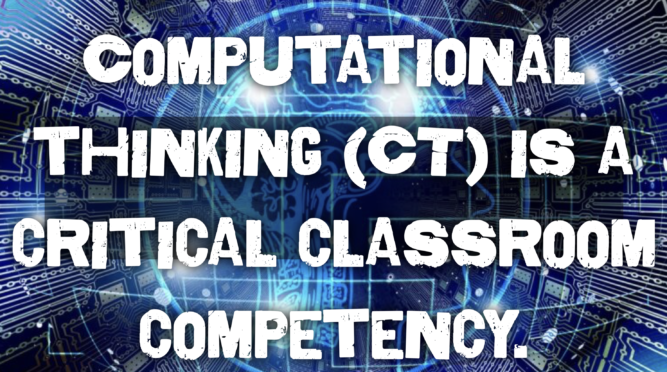“Even the classic acts of solving puzzles or sorting and stacking blocks systematically builds CT skills and agency in solving problems with independence.”
Computational thinking (CT) is a critical classroom competency. Competency refers to the ability to apply skills, knowledge, or understanding to perform a task or accomplish a goal. As the tasks and goals of our students’ (and our own) daily lives continue to become more complex, developing computational thinking skills will be essential to applying those skills, knowledge, and understandings. Competency is demonstrated when contextual comprehension is transferred from understanding to action.

In its simplest form, CT is a problem-solving process. Complex tasks are broken down, patterns are constructed, algorithms may be applied, and innovation is encouraged. Often computer science is integrated into the problem-solving process. To equip our students for their future, computational thinking is as essential as collaboration, communication, critical thinking and creativity (the traditional 4 Cs). If you ask me, computational thinking is the next C.
Computational thinking is often strongly linked to computing, but makerspace creations or STEM challenges like paper clip chains or index card towers also require the analytical and creative design thinking and engineering mojo that CT represents to me. CT does not land fully under the traditional view of computer science, programming, or even devices at all. There’s a reason coding clubs and platforms balance their courses with awesome “unplugged” activities, in which (for example), students pace out a room to “code” their movement to make a physical connection with computational thinking—analog style!
Computational thinking is a critical classroom competency, and all students deserve a basic fluency in coding as a new literacy to connect with their world.
When students program and code their own robots, games, dances, or stories, educators see a tangible application of ideas, critical thinking, and self-expression. They practice authentic and immediate understanding of cause and effect, resiliency, and iterative practice in order to complete their projects, not ourassignments. Watching students create with CT provides an immediate glimpse into their understanding, creativity, and computational thinking as they simultaneously program and problem-solve. Accessibility is always key, and even our youngest learners can code through block and visually-based platforms.
Where digital learning can broadly encompass pedagogy and practice, computational thinking attempts to label cognitive processes and thinking skills. With or without tech, we can begin to build CT awareness and connections to even our youngest students’ lives by identifying patterns and routines, as well as applying problem-solving strategies to complete tasks. Educators can create and identify algorithms across content areas to problem-solve, sequence thinking, and simply create.
It’s impactful to have explicit conversations with students (even early elementary students) about the distinction and relationship between computational thinking and coding. Creating classroom activities that clearly exercise both skills provides the opportunity to pause and identify each.
Even the classic acts of solving puzzles or sorting and stacking blocks systematically builds CT skills and agency in solving problems with independence. Classic board games that require sequence, strategy, logical reasoning, or algorithmic thinking add context for students’ understanding of computational thinking beyond coding tasks. Exploring and identifying how parts of a system, game, program, or product relate, connect, and combine builds foundational concepts for later computational thinking construction.
Where does computational thinking fit into the general education classroom? Tech coaches and specialists are often asked, “How/where does this fit into the curriculum?” My reply? It is the curriculum. Whether or not a district has articulated or adopted learning standards such as the ISTE Computational Thinking Competencies, CT is a scaffolded process of learning that is a whole lot more than something extra, tech-time, or the one-off robot visit. It’s the bridge that connects students’ understanding of the tool they are using now to how they will use tools going forward.
It’s something different, and it’s for everyone.

 For all the kids who grow up in a small town and think they don’t stand a chance. You do. I was once that kid.
For all the kids who grow up in a small town and think they don’t stand a chance. You do. I was once that kid.